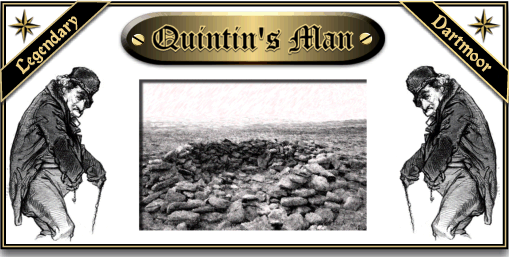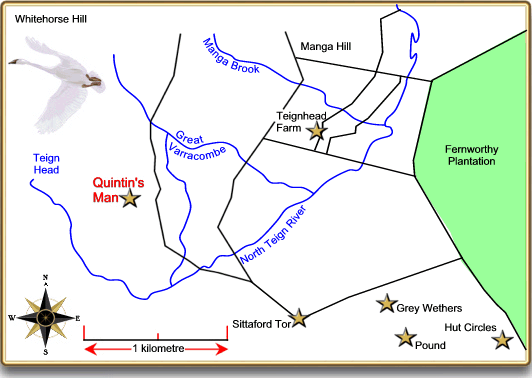
Just under a mile away from the old ruined farm of Teignhead is Quintin’s or Quinter’s Man which today consists of a ruined cairn. Several years ago, an elderly gentleman who lived outside Chagford related a story his grandfather used to tell him as a boy. Sometime in the late 1800s an old tramp used to visit the area on his annual rounds and became well known in the area. His visits were so regular that when the local folk saw him they knew it must be the first two weeks of September. If it happened to be a particularly good year he would spend a few nights camping out in the old ruined cairn. The old tramp would spend the days doing odd jobs in the area, either for coin or food. Having toiled just enough to earn his dinner he would then shamble back up to Quintin’s where he would eat his supper and spend the night under the moorland stars. This particular year he ambled into the area and started visiting his regular ports of call, it was a balmy autumn and so his intention was to camp up at Quintin’s and enjoy the fresh moorland air. The next day the old tramp was seen with his bundle scurrying off the moor in what was described as a, “right tissy”. He was invited into a cottage and plied with several cups of strong tea after which he simply said that there was no way he would ever go near that, “heathen place again”. Everybody agreed that the old tramp at one time had clearly been well ‘schooled’ and was not the kind of fellow open to irrational thoughts so something or someone had clearly scared him witless.
A few days later he was doing some gardening at a small cott when the conversation got around to Quintin’s Man. Up until this point he had never recounted his bad experience but with the help of a, “little drap on medicinals,” his tongue loosened. It transpired that on the fateful night he had just finished his supper of cold bacon, cheese and bread when he heard a strange scraping sound, it was as if somebody was dragging a large granite boulder along the ground. The evening light had just started to fade and the mantle of darkness had just began to draw itself over the moor. About 50 yards away the old tramp saw a hole opening up in the peat and it was being dug by invisible hands. The scraping of granite on granite was getting louder and nearer as it seemed to head for what was now a gaping chasm. Suddenly the sound of human voices could be heard excitedly babbling in a strange tongue from near the hole. A loud thump then rang out across the still moor and a large granite pillar appeared in the centre of the hole, inch by inch the stone began to rise from a 45º angle to a very erect 90º at which point the babbling voices changed into a slow chant. A weird green glow seemed to come from the stone and then a mighty wind howled across the hilltop. No sooner had it passed than the granite pillar, the eerie chanting and the gaping hole simply dissolved into the night air leaving the moor in total silence.
Having related his story the old tramp finished his chores and headed off towards Chagford and that was the last time anyone ever saw him.

The old cairn where the tramp used to camp is still sitting on the hilltop but the interesting thing is the place-name of Quintin’s/Quinter’s Man. There are several places called ‘man’ on Dartmoor – Loughtor Man, Beardown Man and Harbourne Man, and all have derived from the early word, Maen, meaning stone. This element is always applied to menhirs or standing stones so in this light Quintin’s/Quinter’s Man at one time would have indicated the presence of Bronze Age ritual monument. This is all well and good but today there is not the slightest trace of such a structure, so what happened to it and who was Quintin/Quinter ? – nobody knows. The only tenuous suggestion as to the Quintin/Quinter element comes from William crossing where he considers that the name derived from the French word quintin or quintain which means a ‘post’ ???
It is the actual cairn that is now known as Quintin’s/Quinter’s Man which is a total anomaly on Dartmoor as far as the names of cairns go, there is no other example of the man element being used in association with them. So, as there are three examples of menhirs with the man prefix and no cairns it must be logic to say that the menhir has been removed. There are numerous other Bronze Age features in the locality such as the Grey Wethers stone circles, hut circles, pounds etc which could have been associated with a one-time menhir.
Was the story of the old tramp’s experience an attempt to verify the existence of a menhir ? Clearly what he supposedly saw and heard could be construed as a ghostly re-enactment of the erection of a menhir.
 Legendary Dartmoor The many aspects past and present of Dartmoor
Legendary Dartmoor The many aspects past and present of Dartmoor
